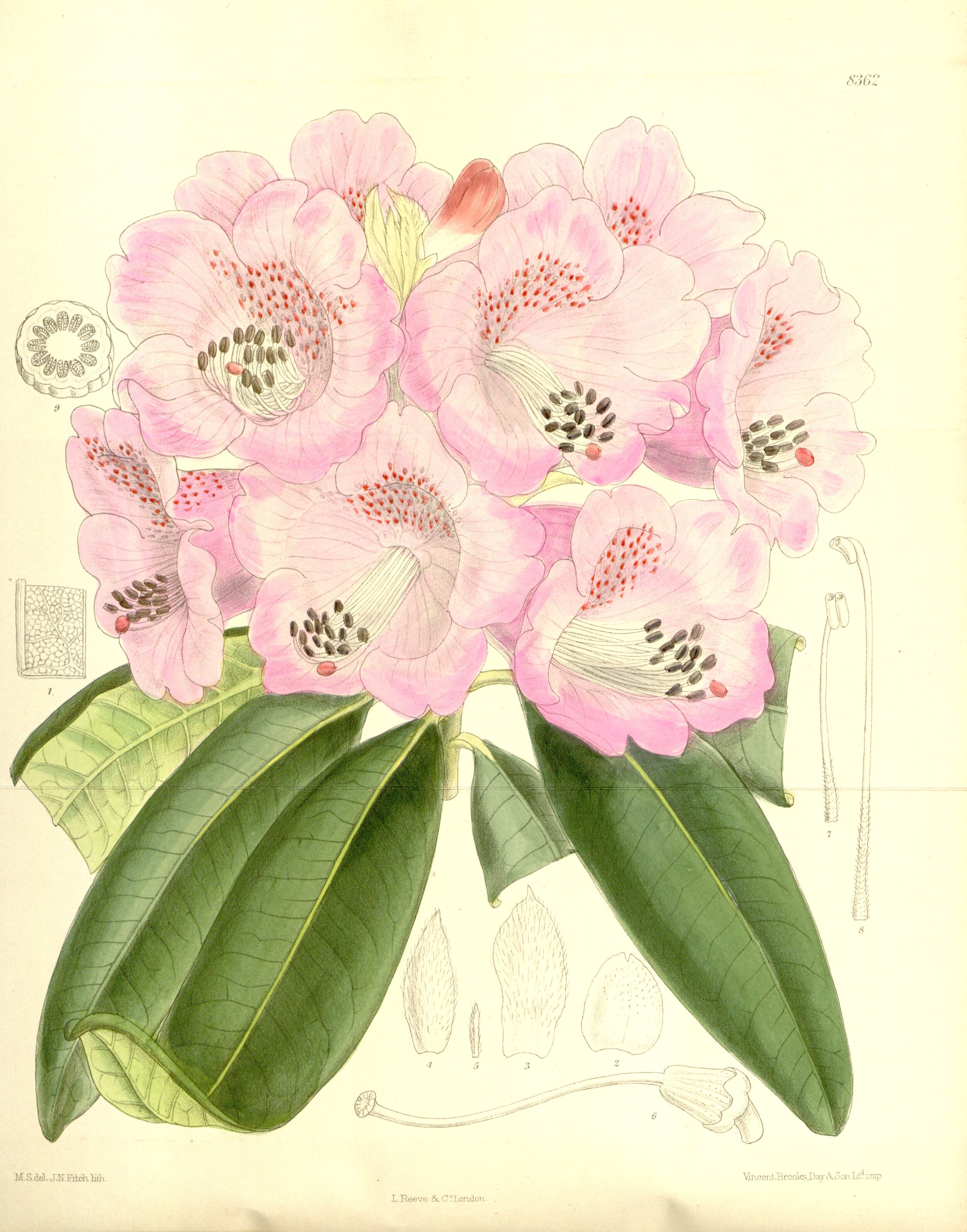In Bloom: Rhododendron sutchuenense has early pink blooms and a majestic treelike habit
By Corinne Kennedy
Our garden’s last remaining Rhododendron sutchuenense, in Area F. (photo: Chie Iida, March 2018)
When our Seattle Japanese Garden opens each year in March, visitors may be surprised to see rhododendrons and azaleas in flower, well before peak of mid-to-late spring bloom. One of the finest of these early bloomers is Rhododendron sutchuenense, often praised as a magnificent species of treelike proportions and beautiful, bold foliage. At least five specimens were planted here in Area F, near the pond’s southern end.
Arboretum records are incomplete, but this species was included in garden designer Juki Iida’s original plant list, so it’s probable that they were planted in 1960, or soon thereafter. [The plants we recognize as “true” rhododendrons, rather than azaleas, are not traditionally planted in the gardens of Japan. However, because of their popularity here, Iida decided that they were appropriate in our Japanese Garden.] Now only one large plant remains – at the south end of the pond, next to the garden’s east side path, and just past the first of three tall ginkgo trees.
Rhododendron sutchuenense is native to China at elevations of 5,000 to 8,000 feet. It’s common in west Hupeh and east Sichuan – typically in woodlands, growing among bamboo or evergreen oaks. Named for the Chinese province of Sichuan where it was collected, it was introduced to Britain in 1901 by renowned plant explorer E. H. Wilson. In 1907, Wilson sent seeds to Harvard University’s Arnold Arboretum, from which this species was widely distributed.
The early lavender-pink flowers, spotted red, of R. sutchuenense. (photo: Yukari Yamano, March 2020)
Sichuan rhododendron is one of the earliest rhododendron species to bloom – in our garden, most often in March – with long-lasting flowers of good substance. Widely bell-shaped, their color varies from white to pale pink to deeper rose or lavender-pink. Loose, flat-topped trusses hold 8 to 12 large flowers spotted red or purple. Our garden’s remaining specimen displays flowers of lavender-pink with red spotting.
According to rhododendron authority and hybridizer, David G. Leach, R. sutchuenense is “one of the best foliage plants in the genus for fine appearance the year round.” Its large, smooth, dark green leaves are paler underneath, and oblong-oval in shape, with curved margins. Five to eleven inches long, they are held below the flower trusses in what Leach calls “a somewhat formal, drooping, fan-like arrangement.” The bark is rough and grayish-brown in color.
Sichuan rhododendron is “probably the hardiest of the larger-leaved [rhododendron] species,” according to our local Rhododendron Species Botanical Garden. It’s cold hardy in Seattle and even in the Boston area, but unprotected flowers in climates colder than Seattle are frequently ruined by late frosts. In our warmer climate, it generally needs only protection from wind and exposure to early morning sun. Unopened flower buds, even when frozen, will develop normally when the weather warms. It’s considered easy to grow, but like all rhododendrons grows best in moist, fertile, well-drained acid soil. A large-leafed species, it prefers light shade or woodland conditions. With time, Rhododendron sutchuenense develops into a large, umbrella-shaped small tree, reaching 25 feet in cultivation – and even taller in the wild.
A related variety, known as R. sutchuenense var. geraldii, has a bold maroon blotch instead of red or purple spotting. Our single specimen, also in Area F, was cut to the ground several years ago and has not regrown.
Showy flower truss and bold foliage of Rhododendron sutchuenense. (image: 1911 lithograph, M. Smith & J. N. Fitch, in Curtis’s Botanical Magazine, London, Vol. 137)
With its treelike habit, beautiful early flowers and bold healthy foliage, R. sutchuenense is a striking plant throughout the year. To me, in habit and effect it’s less like a large shrublike rhododendron, and more like a mature camellia – elegant and treelike. Located prominently next to the east side path, it welcomes us back to the garden and the return of spring.
Corinne Kennedy is a Garden Guide, frequent contributor to the Seattle Japanese Garden blog, and retired garden designer.



